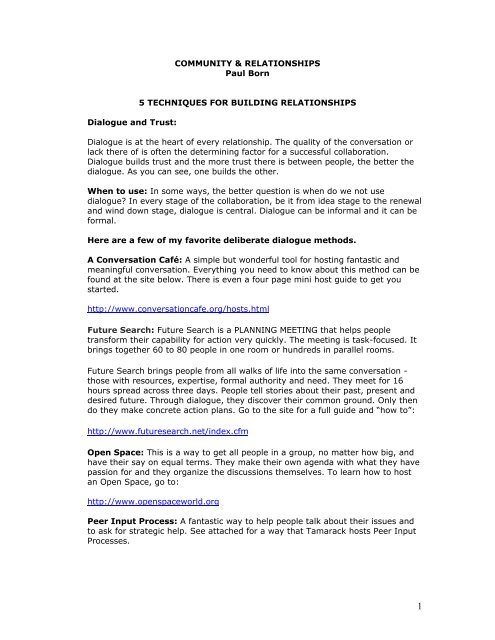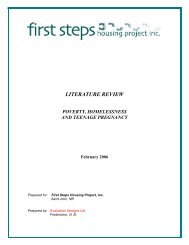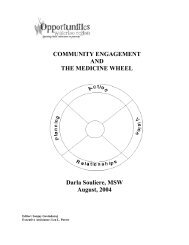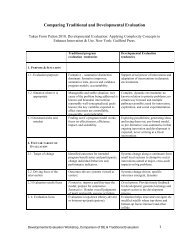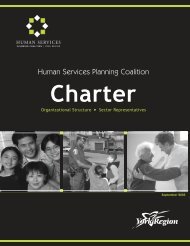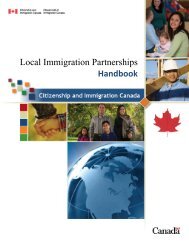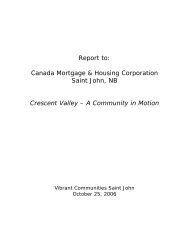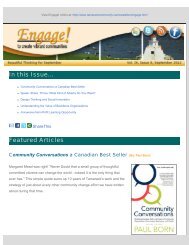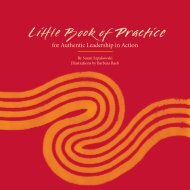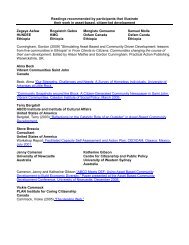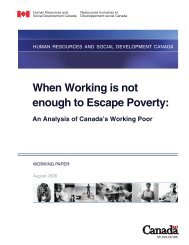5 Techniques for building relationships: - Tamarack
5 Techniques for building relationships: - Tamarack
5 Techniques for building relationships: - Tamarack
You also want an ePaper? Increase the reach of your titles
YUMPU automatically turns print PDFs into web optimized ePapers that Google loves.
COMMUNITY & RELATIONSHIPS<br />
Paul Born<br />
Dialogue and Trust:<br />
5 TECHNIQUES FOR BUILDING RELATIONSHIPS<br />
Dialogue is at the heart of every relationship. The quality of the conversation or<br />
lack there of is often the determining factor <strong>for</strong> a successful collaboration.<br />
Dialogue builds trust and the more trust there is between people, the better the<br />
dialogue. As you can see, one builds the other.<br />
When to use: In some ways, the better question is when do we not use<br />
dialogue? In every stage of the collaboration, be it from idea stage to the renewal<br />
and wind down stage, dialogue is central. Dialogue can be in<strong>for</strong>mal and it can be<br />
<strong>for</strong>mal.<br />
Here are a few of my favorite deliberate dialogue methods.<br />
A Conversation Café: A simple but wonderful tool <strong>for</strong> hosting fantastic and<br />
meaningful conversation. Everything you need to know about this method can be<br />
found at the site below. There is even a four page mini host guide to get you<br />
started.<br />
http://www.conversationcafe.org/hosts.html<br />
Future Search: Future Search is a PLANNING MEETING that helps people<br />
trans<strong>for</strong>m their capability <strong>for</strong> action very quickly. The meeting is task-focused. It<br />
brings together 60 to 80 people in one room or hundreds in parallel rooms.<br />
Future Search brings people from all walks of life into the same conversation -<br />
those with resources, expertise, <strong>for</strong>mal authority and need. They meet <strong>for</strong> 16<br />
hours spread across three days. People tell stories about their past, present and<br />
desired future. Through dialogue, they discover their common ground. Only then<br />
do they make concrete action plans. Go to the site <strong>for</strong> a full guide and “how to”:<br />
http://www.futuresearch.net/index.cfm<br />
Open Space: This is a way to get all people in a group, no matter how big, and<br />
have their say on equal terms. They make their own agenda with what they have<br />
passion <strong>for</strong> and they organize the discussions themselves. To learn how to host<br />
an Open Space, go to:<br />
http://www.openspaceworld.org<br />
Peer Input Process: A fantastic way to help people talk about their issues and<br />
to ask <strong>for</strong> strategic help. See attached <strong>for</strong> a way that <strong>Tamarack</strong> hosts Peer Input<br />
Processes.<br />
1
TOOL – PEER INPUT PROCESS<br />
Working on complex community issues is time consuming and<br />
tough. People working in community organizations often come<br />
across challenges they struggle to overcome on their own.<br />
The Peer Input Process is a technique adapted from peer coaching techniques used<br />
by executives in large corporations designed to assist people in obtaining their input<br />
in a relatively quick and structured way from their peer group.<br />
Step 1 – Introduction (5 minutes)<br />
The Facilitator introduces the purpose of the Peer Input Session, the person-seekinginput,<br />
and the steps in the Peer Input Process.<br />
Step 2 – Unpacking (10 Minutes)<br />
The person-seeking-input takes 10 minutes (if there is time, it is best to use 20<br />
minutes) to share the issue or challenge they are experiencing and finishes their<br />
presentation with a concrete question they would like feedback from their peers on.<br />
Step 3 -- Questions (20 Minutes)<br />
• Clarifying questions (10 Minutes) - Peers now have 10 minutes to ask very<br />
precise clarifying questions to gain a better understanding and more detail.<br />
• Probing questions (10 minutes) - Peers have the opportunity to ask deeper more<br />
probing questions (usually start with ‘Why’ or ‘How’).<br />
Step 4 – Group Discussion (20 Minutes)<br />
The peer group now has a chance to talk to each other in answering the question<br />
posed. The presenter cannot at any time interject – they are simply “listening in” to<br />
the conversation.<br />
Step 5 – Reflections (5-10 Minutes)<br />
The Person-seeking-input reflects on the process and what they may or may not<br />
have learned, and shares how they might proceed with their question based on the<br />
group’s input.<br />
Step 6 – Wrap Up<br />
The Facilitator wraps up the event.<br />
2
TOP 100 PARTNERS EXERCISE<br />
Consider the top 100 people and organizations in your community that, “if<br />
they were working together to change the community toward the vision you<br />
represent” you could realize the change you want to see.<br />
The easiest and least effective way <strong>for</strong> partnerships to emerge is to just let them<br />
happen. I am a huge believer in emergence but given that partnerships take so<br />
much time to develop, I feel it is very important to know who you want your partners<br />
to be and to develop a strategy <strong>for</strong> <strong>building</strong> these <strong>relationships</strong>.<br />
Here is a five step process that individuals or groups can use to be much more<br />
deliberate in <strong>building</strong> strategic partnerships.<br />
When to use: This exercise is most helpful when first <strong>building</strong> the collaboration and<br />
after the idea is in draft <strong>for</strong>m. It is also useful as you are holding consultations <strong>for</strong><br />
the development of the community plan to ensure you are engaging key stakeholder<br />
ideas. It is again a useful exercise once you have completed the community plan and<br />
want to double check to ensure those not yet involved but should be are.<br />
Step one: Consider the issue you hope to address in your community. List all the<br />
organizations (top 100) that make up the system around the issue – if possible,<br />
identify the people that lead them or work in them. If your issue is poverty<br />
reduction, consider the agencies that serve the poor, food banks, low-income<br />
neighborhood centers, homeless shelter. Consider the employers that hire lowincome<br />
workers, be they private or public. Also, consider those business associations<br />
that represent those employers like your chamber of commerce. Consider all levels<br />
of government that support or fund programs that help the poor. Lastly, identify any<br />
citizen organizations that have been developed by those poor <strong>for</strong> the poor. Maybe a<br />
single parent support group. Keep writing down names until you cannot think of any<br />
more.<br />
Optional, but a useful image:<br />
On a large piece of paper, write the name of the collaborative you are involved in.<br />
Visualize all those in your community who have similar interests, including existing<br />
partners.<br />
Brainstorm those organizations that make up the system you are hoping to affect<br />
using the four categories of Business, Voluntary, Government and people affected by<br />
the issue. After listing them all on the right hand side of the page in front of you<br />
(map them out by drawing lines using colors to represent the strength or nature of<br />
the relationship, i.e. Green <strong>for</strong> strong, pink <strong>for</strong> weak, etc., on each line), write what<br />
you might do to strengthen that relationship or group of <strong>relationships</strong>.<br />
Step two: Sort through the list and identify the people you know best. Organize the<br />
lists in groups such as Business, Government, Voluntary Sector and Low-income<br />
Leaders.<br />
Step three: Now rank the lists - such as identifying the top three in each list. Use<br />
specific criteria <strong>for</strong> ranking - this is how I do it. Those individuals that I or anyone in<br />
our group has a close personal relationship with get 5 points – <strong>for</strong> those with a lesser<br />
3
elationship, they get a lower rating. How do you know you have a good<br />
relationship? If you can ask this person a reasonable favor and if because of your<br />
relationship they would most often say yes – it is a level 5 relationship. Now, also<br />
rank each contact <strong>for</strong> ability to contribute to implementing the vision. Again, if they<br />
have a lot of influence or resources - give them a five. Lastly, rank them <strong>for</strong><br />
“readiness to partner.” How closely does your idea line up with their thinking? Are<br />
they in the midst of a huge change that your idea fits with nicely? If it does not and<br />
they are doing their own thing, the rating may be lower.<br />
Step four: Choose the partners you most want to approach first. This is most often<br />
called “ranking your prospect list.” This stage often requires some research. The<br />
more you know about a potential partner, the easier it is to customize “the ask” in a<br />
way that they can easily see the need and benefits of their participation.<br />
In this step, I normally look <strong>for</strong> two things. The first is a set of names that will give<br />
me some quick partnerships – those people I know well and am fairly sure will join in<br />
if ask. The second is those on my list with significant influence. An example of this is<br />
the Mayor of the city or a leading business person. These are people who bring<br />
credibility to the issue and, once they are on your side, it is often much easier to<br />
bring on other key community influencers.<br />
Step five: Make the approach but go slow! I have a simple rule – I never ask a<br />
partner to commit on my first visit with them. I use the first meeting to introduce the<br />
idea and try to leave the meeting with a commitment <strong>for</strong> a second meeting. At the<br />
end of the first meeting I ask, “Ss there other in<strong>for</strong>mation I can send to you, or<br />
questions that I might answer when we get together again?”<br />
This five step process is not conclusive but, rather, it is a way to be deliberate about<br />
the <strong>building</strong> of <strong>relationships</strong> and to identify the “top 100” organizations and<br />
individuals that can contribute to the change you want to see <strong>for</strong> your community.<br />
4
BUILD A RELATIONAL DATABASE<br />
Every event that you hold and every conversation you have about the<br />
change you want to see is an opportunity to build a relationship. By aquiring<br />
email addresses or business cards, you have an opportunity to keep people<br />
in<strong>for</strong>med and, hopefully, get them excited about the work you are doing.<br />
Imagine after one year you might have more than 1,000 names in your<br />
database and a short note <strong>for</strong> each as to why they are important and<br />
interested in your work, and how they have been involved to date.<br />
When to use: In every stage of collaboration, this is important. I would suggest this<br />
is the most important discipline of any collaborative organization. Keeping a<br />
relational database creates a discipline that keeps the <strong>relationships</strong> <strong>for</strong>med current<br />
and deliberate.<br />
What is a relational database? We all have mailing lists and, at times, we use<br />
excel spreadsheets and, at other times, we might use specific software that allows us<br />
to keep the names and addresses of the people we connect with regularly. A<br />
relational database can be just that a listing of names and contact in<strong>for</strong>mation. What<br />
makes it relational is that we have developed categories <strong>for</strong> each contact so they can<br />
be sorted by interest or level of importance to us.<br />
A few tips:<br />
o<br />
o<br />
o<br />
o<br />
o<br />
Every event you hold is an important opportunity to build your database.<br />
Make sure that you find a way to get names and email addresses. This might<br />
involve a sign up sheet that is passed around. Or, find a reason to send some<br />
compelling in<strong>for</strong>mation after the meeting and ask <strong>for</strong> email addresses be<strong>for</strong>e<br />
they leave. If you have a newsletter, have them sign up <strong>for</strong> that.<br />
This is a discipline! In other words, it must become something you do<br />
everyday and <strong>for</strong> every event. Even if you already have the contact<br />
in<strong>for</strong>mation, you may now have more in<strong>for</strong>mation about a person or able to<br />
track a specific event and interest they might have. Consider a one year goal?<br />
A thousand names one day, one event at a time.<br />
Consider using the database as a way of tracking engagement. I cannot think<br />
of a better way to track how many people have been involved in the initiative<br />
to date and their level of interest and contribution. Make sure this is part of<br />
your evaluation criteria.<br />
Consider buying a data base that is built specifically <strong>for</strong> this purpose. The one<br />
we use and can be purchased <strong>for</strong> around $200 is the Act data base go to<br />
www.act.com <strong>for</strong> more in<strong>for</strong>mation.<br />
Use the database! The best way to see the power of the database is to<br />
develop a short e – letter that provides a compelling update of your work on a<br />
regular basis. Some might say the internet is part of what is allowing<br />
collaborative work to grow at that pace it is. How easy it is to keep everyone<br />
in<strong>for</strong>med.<br />
5
COMMUNICATION AND LEARNING<br />
Communication is critical to a collaborative ef<strong>for</strong>t. Not just any<br />
communication – it must be purposeful and consistent if it is to be effective.<br />
We have found that communication that helps people learn is more effective<br />
than communication that keeps people up to date on the work going on (we<br />
realize both are needed). By creating a continual learning system, we help<br />
people engage in the ideas around the change we want to see and, as such,<br />
build their commitment to contributing to the ideas becoming a reality.<br />
When to use: In every stage of the collaboration, communication and learning is<br />
critical. Consider a deliberate communication system that includes events, a<br />
newsletter and a website, as well as “hard copy” papers and documents that people<br />
can keep or pass along.<br />
Tips <strong>for</strong> communication:<br />
o Build a learning community, not just a constituency. A learning community is<br />
one in which every member is seen as a contributor and participant to the<br />
learning that is occurring. It allows you to build a body of practice, most often<br />
housed on your website. It sees every event and communication with<br />
members of the learning community as an opportunity to build knowledge<br />
and understanding.<br />
See Cultivating Communities of Practice by Etienne Wenger, Richard<br />
McDermott, William M. Snyder <strong>for</strong> a great resource on <strong>building</strong> learning<br />
communities.<br />
o<br />
o<br />
o<br />
o<br />
Email is an effective communication tool, as it allows us to keep in<strong>for</strong>mation n<br />
front of people easily. Be deliberate and consistent but do not over use this<br />
tool. Consider a bi-weekly communication (ideal) or monthly, but no more<br />
than that.<br />
See communication as <strong>building</strong> a learning system. We recommend that you<br />
develop an annual learning plan <strong>for</strong> your collaborative. Consider an annual<br />
learning theme and how you might use events and papers to further the<br />
learning communities understanding of the issue you are promoting.<br />
Face-to-face learning is critical in <strong>building</strong> trust and understanding. Use faceto-face<br />
events <strong>for</strong> <strong>building</strong> this trust and by giving people plenty of time <strong>for</strong><br />
communication with each other. See virtual learning as enhancing the faceto-face<br />
learning events.<br />
Make it easy <strong>for</strong> people to learn. People are overwhelmed today with the<br />
amount of in<strong>for</strong>mation they receive. Animate knowledge using quick<br />
summaries of a document and then by giving people the option to download<br />
the whole thing. Use pictures to make your products user-friendly. Consider<br />
how you might make each document personal and fun. Telling stories about<br />
individuals is very effective, especially if you are telling the story as a way of<br />
animating the change you are hoping others emulate.<br />
6
CELEBRATION<br />
Saying thank you might seem like an easy thing to do, but it is done far too<br />
seldom. Our experience is that asking <strong>for</strong> help may be the biggest<br />
compliment you can give any person, especially if you are able to say thank<br />
you to them in an authentic way. People love to be needed and want to<br />
know that their help made a difference.<br />
When to use: Always! Build a culture of generosity – a community where thank you<br />
is a way of being.<br />
Some celebration ideas:<br />
o<br />
o<br />
o<br />
o<br />
o<br />
As leader, the ability to say thank you even <strong>for</strong> the small things may be the<br />
most important competency a collaborative leader can have. This sounds<br />
easy! It is not. As we get caught up in the pressures of our job, when we<br />
work 50 hours a week, when things are taking longer than they should, we<br />
become depleted and tired. As we are constantly asking people <strong>for</strong> help, we<br />
are the ones saying thank you and are seldom the ones being thanked. Over<br />
time, this depletes our energy and we lose a sense of gratefulness. Thank you<br />
and please are replaced with, “they did not follow through again,” “they could<br />
have done better,” or even worse, we replace a spirit of generosity with a<br />
spirit of blame. Guard against this, consider hiring a professional coach or<br />
asking a mentor to coach you through this process of leadership. Ask them to<br />
help you maintain a spirit of thank you ad generosity.<br />
Use your communication and learning events to say thank you. Consider<br />
profiling a leader and their work. Mention a few people during your<br />
introductory comments at a community or leadership roundtable meeting.<br />
Hold an annual celebration event! Recognize people and accomplishments.<br />
Establish awards and make them generous and unique. We once had a<br />
famous artist donate prints of a painting with the theme of working together<br />
to give to people. We would share these and tell the persons story. It is<br />
interesting how these types of awards became a vehicle not only to say thank<br />
you, but also to motivate others in the community. People love to be part of<br />
thankful organizations.<br />
Be personal and care about people in every aspect of their lives. Go to<br />
funerals, send flowers, and buy lunch. Ask people how it is going and take the<br />
time to hear what is really happening with their children, in their extended<br />
family or with their health. Try and remember ways to care. Caring of course<br />
is the authentic thank you.<br />
7


